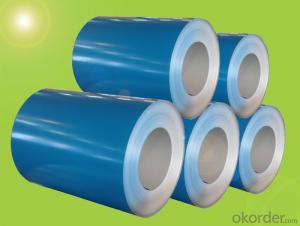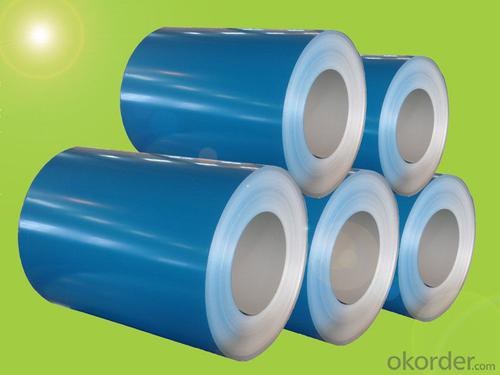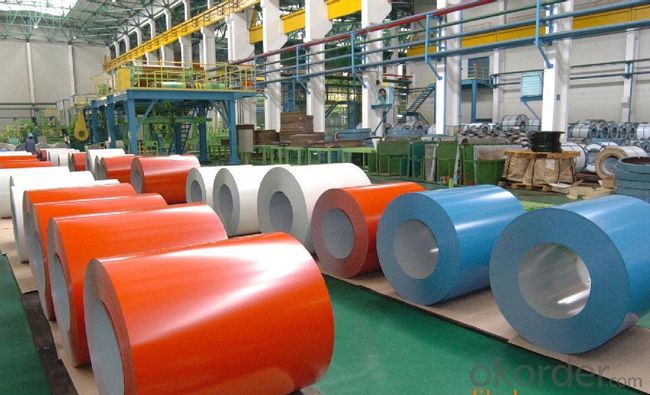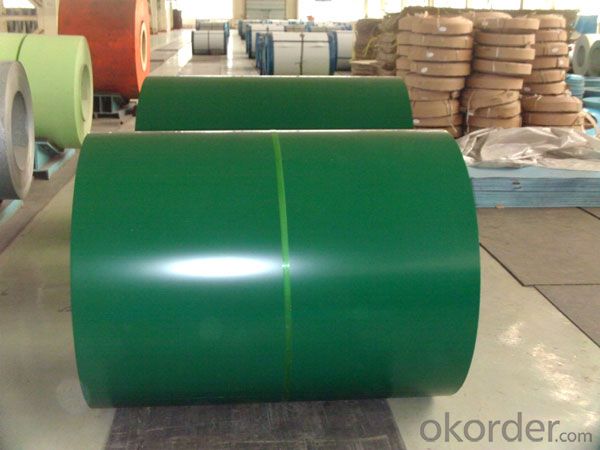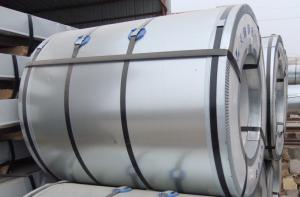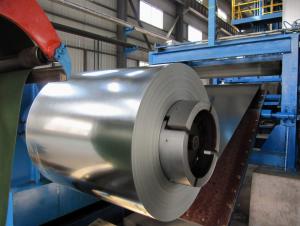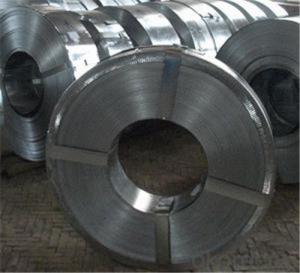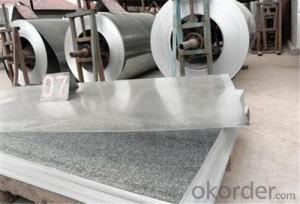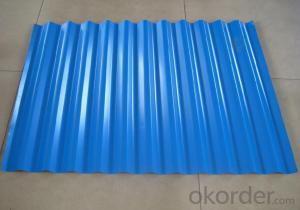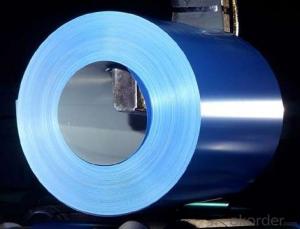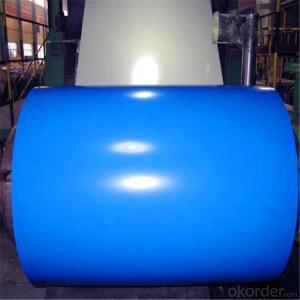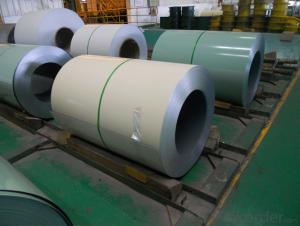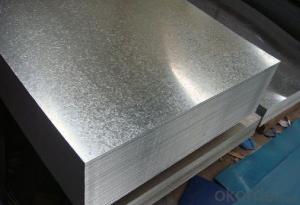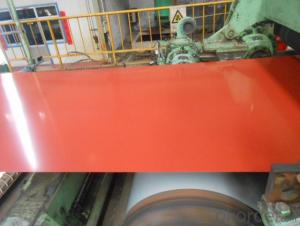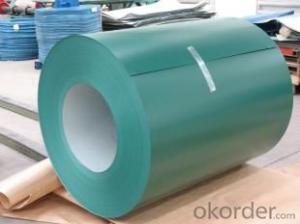High Quality PPGI
- Loading Port:
- China Main Port
- Payment Terms:
- TT OR LC
- Min Order Qty:
- -
- Supply Capability:
- -
OKorder Service Pledge
OKorder Financial Service
You Might Also Like
Product Features
super weather resistance and durability , also the pattern is capable to bring about plenty of effects of multilayer, parallax and 3D effect.
Application
It is the perfect building material in construction for making steel roofing/suspended ceiling, office partition, Sandwich panel, insulation panel, corrugate sheet, facade wall,rolling doors, T-bar, garage door and shutters etc.
Structure of Cross-section
Items | Thickness | Type | Features |
Protection Film | 50μm | polyethylene | Protecting from scratches and |
Finished Coat | 10μm | PVDF | Protecting printed layer and enhances |
Print | ≦1μm | Ink, Polyester | Various printing patterns,3 colors overprint |
Top Coat | 20μm | Polyester Fluorine | Chemical resistance, formability and |
Primer Coat | 5μm | Polyester | workability, corrosion resistance and |
Chemical Treatment | ≦1μm | Chromate | Good adhesion and corrosion resistance |
Substrate | 0.2-1.2mm | GI.GL.AL | GI.GL,AL |
Chemical Treatment | ≦1μm | Chromate | Good adhesion and corrosion resistance |
Back Coat | 5μm | Epoxy | corrosion resistance and adhesion to the |
- Q: When and where did soldiers wearing steel protective helmets start ?It seems to have been common by the start of WW1
- They used to wear entire steel suits of armor in the middle ages. They stopped wearing the armor with the invention of reliable firearms, but steel helmets have been around since then. Before that, they wore iron or bronze helmets. Some armies went to a soft cap through the mid 1800s until fragmentary type artillery rounds appeared. Then helmets started coming back again. WWI was the big return.
- Q: I mean, besides the light weight and other graces of Aluminium and Carbon, Steel frames are absolutely out-dated and they have nothing to do these days... or it is still possible to enjoy a nice ride on our heavy old pals?
- Au contraire; many great bikes are still steelies. Today's steel is much lighter than 10 yrs ago.
- Q: What are the different types of steel coil slitting methods?
- There are several different types of steel coil slitting methods, including rotary shear, loop slitting, and oscillating shear. Each method has its own advantages and is used for different applications in the steel industry.
- Q: What are the different types of steel coil surface finishes for aesthetics?
- There are several different types of steel coil surface finishes that are commonly used for aesthetics purposes. These finishes are applied to the surface of the steel coil to enhance its appearance and provide a desired aesthetic appeal. Some of the most popular types of steel coil surface finishes include: 1. Polished Finish: This type of finish involves using abrasive materials to create a smooth and reflective surface on the steel coil. It provides a high-gloss look and can be further enhanced by using different levels of polishing. 2. Satin Finish: Also known as brushed finish, this type of surface finish involves using a fine abrasive material to create a soft and matte appearance on the steel coil. It provides a subtle sheen and a textured effect. 3. Etched Finish: This finish involves using a chemical process to create patterns or designs on the surface of the steel coil. It can be used to create intricate and decorative designs, making it a popular choice for architectural applications. 4. Embossed Finish: This type of finish involves pressing or stamping a pattern onto the surface of the steel coil. It creates a raised design that adds texture and visual interest to the steel coil. 5. Powder Coated Finish: In this finish, a dry powder is applied to the steel coil and then heated to form a protective and decorative coating. It is available in a wide range of colors and provides a durable and vibrant finish. 6. Painted Finish: This type of finish involves applying a layer of paint to the surface of the steel coil. It allows for customization in terms of color and provides protection against corrosion and other environmental factors. These are just a few examples of the different types of steel coil surface finishes available for aesthetic purposes. Each finish offers a unique look and can be selected based on individual preferences and project requirements.
- Q: Can steel coils be coated with tin?
- Yes, steel coils can be coated with tin.
- Q: How are steel coils used in the production of steel latches?
- Steel coils are used in the production of steel latches by being processed into flat sheets or strips, which are then cut and shaped to form the various components of the latch. These coils provide a ready-to-use source of high-quality steel, ensuring the strength and durability of the final product.
- Q: How are steel coils used in the production of furniture components?
- Steel coils are commonly used in the production of furniture components as they provide a strong and durable material for construction. These coils can be shaped, cut, and formed into various components such as frames, supports, and brackets, adding strength and stability to the furniture. Additionally, steel coils can be coated or painted to enhance their appearance and protect against corrosion, making them versatile and long-lasting materials for furniture manufacturing.
- Q: How do steel coils contribute to the manufacturing of oil and gas equipment?
- Steel coils play a vital role in the production of oil and gas equipment, as they are an essential component. Typically, these coils are made from high-quality steel that is durable, strong, and resistant to corrosion. This makes them ideal for enduring the harsh environments and conditions encountered in the oil and gas industry. One of the primary uses of steel coils in oil and gas equipment manufacturing is in the creation of pressure vessels. These vessels are crucial for storing and transporting fluids and gases under high pressure. Steel coils are used to form the cylindrical shells of these vessels, providing the necessary strength and structural integrity to withstand the internal pressure. Steel coils are also utilized in the construction of oil and gas pipelines. These pipelines are responsible for transporting large quantities of oil and gas over long distances. Steel coils are used to manufacture the pipes that compose these pipelines, ensuring they have the necessary strength, durability, and resistance to corrosion. The coils are rolled and welded to create seamless or welded pipes, which are then coated or lined to prevent corrosion and increase their lifespan. Additionally, steel coils are instrumental in the production of drilling equipment used for extracting oil and gas. This equipment includes drill bits, casings, and wellheads, which are essential for drilling and completing wells. The coils are used to fabricate these components, ensuring they can withstand the demanding conditions encountered during drilling operations. Aside from their structural applications, steel coils are also used in the manufacturing of ancillary equipment like tanks, storage containers, and heat exchangers. These components play a crucial role in the processing, storage, and distribution of oil and gas. Steel coils provide the necessary strength and durability to handle the harsh conditions and corrosive substances encountered in these processes. In conclusion, steel coils are indispensable in the manufacturing of oil and gas equipment. Their strength, durability, and resistance to corrosion make them a preferred choice in the industry. By contributing to the fabrication of pressure vessels, pipelines, drilling equipment, and ancillary components, steel coils ensure the safe and efficient extraction, processing, and transportation of oil and gas.
- Q: can you play one?
- Yessir. No, I can only play a piano and Guitar Hero.
- Q: How are steel coils used in the production of structural components?
- Steel coils are an integral part of the production process for structural components. These coils, which are made of steel that has been rolled into a continuous strip, provide the raw material necessary for manufacturing a variety of structural components, such as beams, columns, and trusses. The first step in using steel coils for structural components involves uncoiling the strip and cutting it into the desired lengths. This can be done using a variety of cutting methods, such as shearing or sawing. Once the coils are cut into lengths, they are then processed further to shape them into the specific structural components needed for a particular project. One common method used to shape steel coils into structural components is through the process of bending or forming. This involves using specialized machinery to bend or shape the steel into the desired configuration. For example, a steel coil can be bent into an I-beam shape, which is commonly used as a load-bearing structural component in buildings and bridges. Another method used to shape steel coils into structural components is through the process of welding. This involves joining multiple steel coils together to create a larger component. Welding is often used to fabricate components such as columns or trusses, which require the combination of multiple steel coils to achieve the necessary strength and structural integrity. Once the steel coils have been shaped and formed into the desired structural components, they may undergo additional processes, such as surface treatment or coating, to enhance their durability and resistance to corrosion. This ensures that the components will have a long lifespan and can withstand the demands of their intended applications. In summary, steel coils are essential in the production of structural components as they provide the raw material necessary for manufacturing. Through processes such as cutting, bending, and welding, steel coils are shaped into the specific components needed for various construction projects. These components play a crucial role in supporting the structural integrity of buildings, bridges, and other structures.
Send your message to us
High Quality PPGI
- Loading Port:
- China Main Port
- Payment Terms:
- TT OR LC
- Min Order Qty:
- -
- Supply Capability:
- -
OKorder Service Pledge
OKorder Financial Service
Similar products
Hot products
Hot Searches
Related keywords
